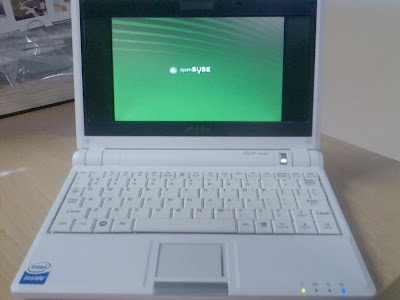

So I got my Asus EEE. I have been wanting one since the announcement. Being someone who is about to travel, and a linux user, I wanted something extermely portable. So I bought it. It cost me R3200, roughly $400, for a 4G Surf, google it for the spec.
So, after using the official Xandros for a day or so, and getting annoyed with the lack of features and, being a programmer by profession, the lack of decent software repositories, I decided to hack it a little. First enabling full desktop mode helped. But still this didn't solve most of my issues. Being an openSUSE user I opted for that. Although it is a bit heavy, it still works nicely, without slowing the pc down. This is how I did it, very simple indeed:
- Borrowed a USB DVD-Rom from our system admin at work.
- Put the dvd in, and configured bios to make sure the boot order was set up properly. To do this, hit F2 as the machine has just turned on. Go to the boot tab, and change the Boot Device Priority to allow you're dvd rom to be the first in the list.
- Boot up the install system. Go through all the usual steps to get it going, until you hit the partition setup step. When asked, you need to create a custom partition setup. Create a 3GB partition, mounted at / and a ~700mb partition mounted at /home which should give you just enough space. If you have something like a SD card, rather use your internal drive all for / and the sd card for the /home partition. Another thing, apparently, is to edit the fstab options to enable the noatime switch. This helps extend the life of the internal solid state drive. I am not sure how important it is really, but I did it anyway. When done it might warn you about not having a swap partition, just ignore it by clicking no. The reason for this is the same as the reason for the noatime flag, extending the life of the drive.
- Change the package selection to get rid of some uneeded stuff. I am a coder who browses the net a lot, so for me OpenOffice and KOffice are not important and would be happy to use google docs, so those were unmarked in my install list.
- Go ahead and install. This is the longest step.
- All the rest of the setup is standard, when you are done, just boot the system, and there you have openSUSE 10.3 on your asus eee.
- Once in, to get wireless lan, lan, and some power management stuffs working, download:
Download these on another pc with net connection, and then use a flash or something to transfer across to you EEE. Install them in any order, reboot, and all should work as expected!
Thats all that is needed to get openSUSE 10.3 onto an Asus EEE pc. Enabling the compiz fusion desktop effects was simple, open a command line and type:
sudo gnome-xgl-switch --enableType in the root password, reboot, and compiz and the 3D desktop effects will be active. I wasn't happy with performance when this was on, so i disabled it using:
sudo gnome-xgl-switch --disableAgain typing in the root password and rebooting. Strictly the reboot isn't needed, but getting it to work without can be a little complicated.
All done!!








